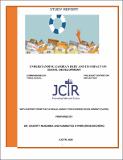Understanding Zambia’s Debt And it’s Impact on Social Development
Date
2020Authors
Musamba, Charity Dr
Phiri, Kumbutso
Type
OtherLanguage
enItem Usage Stats
549
views
views
343
downloads
downloads
Abstract
This report presents the findings, discussions and recommendations of the study in entitled, “Understanding Zambia’s Debt and Its (Social) Impact,” commissioned by the Jesuit Center for Theological Reflection (JCTR) with support from the Catholic Agency for Overseas Development (CAFOD) in August 2020. The study is divided into five (5) main parts. Part One provides basic information on the Research. Part Two (2) focuses on the Methodology used to conduct the study. Part Three (3) presents the findings and interoperation of the findings of the study while Part Four (4) presents the “Moral Case” for Debt Cancellation for Zambia” and Part five (5) presents the conclusion and recommendation. With regard to the overall findings of this study, there are two major points worthy of note. First and foremost, is Zambia’s current overall debt stock is high and unsustainable. The current debt of US$18.5b is inhibiting Zambia from overcoming the current economic downturn which are running around 2% to 3% and expected to run into negative growth by 2021. The “unattainability” of this debt are well exemplified by unpacking the relation of debt to the following - declining national revenues and high exchange rate coupled with rising debt servicing obligations and
domestic expenditures. Second, it is also clear that Zambia is not in a position to borrow as evident in the move by Government to “halt” loans in the pipeline, only spend on projects that are in the completion phase. Third, it is also clear from this study that Zambia has reached a point of incapability to repay or service its debt when repayment fall due. The various calls to the creditors by the national leadership consider Zambia for debt cancellation or relief as well as inability to service the Eurobond payment of US$22.5billion in October this year are points in case. For these reasons, the study contends that it will not be possible for the Government of Zambia to adequately plan and finance national development needs, especially those related to human development and poverty reduction given its incapability to develop the economy, inability to generate adequate services but
expected, at the same time, to meet its debt and debt service obligations. It is important to mention that poverty in Zambia is still high. At present, poverty stands at 54%. This means that over half of the total number of eighteen million Zambians are living in poverty. The Country is also one of the most unequal societies in Africa. Currently, inequality stands at 0.56 (Gini coefficient) in the Southern region of Africa.
Description
Zambia was already ranked as a “high risk case” in 2015, 2017 and 2019 (IMF 2016, 2018, 2020). The crisis of debt can be traced as far back as 2011 (World Bank, 2017). Initially, the Country’s debts were massively reduced by the 2008 because the country had benefited from debt relief initiatives such as the Heavily Indebted Poor Countries (HIPC) and the Multilateral Debt Relief Initiative (MDRI). The country’s debt stock reduced from US$7.2billion to US$2.5billion as result of the application of these two debt relief initiatives. However, by 2019, the official external debt of Zambia had already shot up to US$ 10.23 billion in 2019 (GRZ 2020). Presently, it is estimated that overall public debt (external and internal) about seventy one (71) percent of Zambia’s annual GDP up from ten (10) percent in 2011. For example, domestic debt grew by an annual average of 2.3% of GDP while foreign public debt as a proportion of GDP increased from 22.9% in2011 to 47.3% by the end of 2017 (World Bank, 2018). The total public and publicly-guaranteed debt including domestic arrears at end-2018 was at 73.1 percent of GDP (IMF Staff, 2019). A large proportion of Zambia’s current debt stock is non-concessional (commercial). The continual increases in public debt in Zambia after 2006 has resulted in an exponential increase in public debt servicing costs (Ndhlovu and Chishimba, 2019). These payments have adversely affected poverty alleviation programmes and have also directly impacted negatively on credit creation, gross national savings, domestic interest rates, gross national investment and gross revenue performances of the central government (World Bank, 2017
